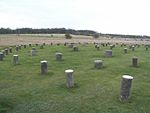Durrington Walls

Durrington Walls is the site of a large Neolithic settlement and later henge enclosure located in the Stonehenge World Heritage Site in England. It lies 2 miles (3.2 km) north-east of Stonehenge in the parish of Durrington, just north of Amesbury in Wiltshire. The henge is the second-largest Late Neolithic palisaded enclosure known in the United Kingdom, after Hindwell in Wales.Between 2004 and 2006, excavations on the site by a team led by the University of Sheffield revealed seven houses. It has been suggested that the settlement may have originally had up to 1,000 houses and perhaps 4,000 people, if the entire enclosed area was used. The site was settled for about 500 years, starting sometime between c. 2800 and 2100 BC.The site may have been the largest settlement in northern Europe for a brief period. From 2010 to 2014, a combination of new technology and excavations revealed a 500-metre-diameter (1,600 ft) henge constructed largely of wooden posts. Evidence suggests that this complex was a complementary monument to Stonehenge.In 2020, a geophysical survey uncovered a number of pits, some natural sink holes and others apparently modified to hold massive timbers, interpreted as belonging to a 1.2-mile-wide (1.9 km) circle or circuit of 10-metre (33 ft) pits of Neolithic age. If this interpretation is correct, this would be Britain's largest prehistoric monument.
Excerpt from the Wikipedia article Durrington Walls (License: CC BY-SA 3.0, Authors, Images).Durrington Walls
Wells Close,
Geographical coordinates (GPS) Address External links Nearby Places Show on map
Geographical coordinates (GPS)
| Latitude | Longitude |
|---|---|
| N 51.1925 ° | E -1.7875 ° |
Address
Durrington Walls
Wells Close
SP4 8LY , Durrington
England, United Kingdom
Open on Google Maps








